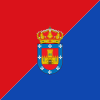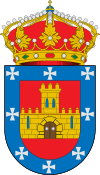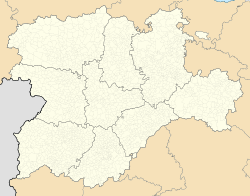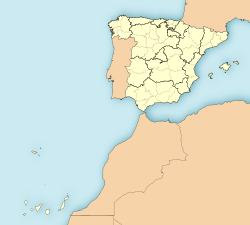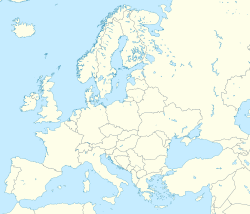Santoyo facts for kids
Quick facts for kids
Santoyo
|
|||
|---|---|---|---|
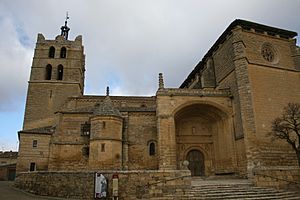
Church of St. John the Baptist
|
|||
|
|||
| Country | |||
| Autonomous community | |||
| Province | |||
| Comarca | Tierra de Campos | ||
| Area | |||
| • Total | 34.69 km2 (13.39 sq mi) | ||
| Elevation | 780 m (2,560 ft) | ||
| Population
(2018)
|
|||
| • Total | 197 | ||
| • Density | 5.679/km2 (14.71/sq mi) | ||
| Time zone | UTC+1 (CET) | ||
| • Summer (DST) | UTC+2 (CEST) | ||
| Postal code |
34490
|
||
| Dialing code | 979 | ||
Santoyo is a small town, also called a municipality, located in the province of Palencia, which is part of the Castile and León region in Spain.
Contents
History of Santoyo
The area where Santoyo is today has been lived in since at least ancient times. On the Sarnallano moor, you can find old remains of a Vaccaean fort. A Roman country house called "Las Quintanas" was built here around the 4th century. In the 1990s, archaeologists found an oven, a Roman heating system, some pottery (both fancy and everyday types), and a well filled with old items.
All these early settlements were left empty after the Visigothic Kingdom ended. The Santoyo we know today was settled again in September 988. This was done by Fernán de Armentales, who was a loyal follower of Count García Fernández of Castile. The town's name likely comes from the Latin words Sanctus Ioannes, meaning "Saint John". In the 11th century, Santoyo was a town with strong walls, but only a few parts of these walls remain today.
Church of St. John the Baptist
The Church of St. John the Baptist started as a Romanesque style church in the late 12th century. You can still see this early style in some windows in the middle part of the church. The bell tower, built in the late 13th century, shows a mix of Romanesque and Gothic styles. The parts of the church that form a cross shape, the altar area, and the rounded end were built in a fancy Flamboyant Gothic style in the 15th century. This style is similar to parts of the famous Burgos Cathedral, and was built by Juan de Arce and Martín de Solórzano.
The main entrance on the south side of the church has a beautiful plateresque porch. This porch is known as the patriarch's portico because it was paid for by Antonio de Rojas Manrique, who was a high-ranking church official in the 16th century.
Inside the church, the most important feature is the Renaissance reredos, which is a large, decorated screen behind the altar. It was paid for by Sebastián Cordero de Nevares. You can also find an old Visigothic baptismal font and a plateresque (15th century) pulpit made of walnut wood. The choir area has a Baroque organ, built in 1738 by Pedro Merino de la Rosa. It also has carved walnut choir stalls finished in 1750 and a 16th-century mudéjar wooden ceiling (built between 1490 and 1510).
This church is very important and has been listed as a Bien de Interés Cultural, meaning it's a protected historical site.
Organ
The organ in the church is a Baroque instrument built in 1738 by Pedro Merino de la Rosa. It has a single keyboard with 45 notes.
Other Important Places
- Chapel of Nuestra Señora de Quintanilla: This is another important religious building in Santoyo.
- Las Quintanas Roman villa: These are the remains of the old Roman country house mentioned in the history section.
- Rollo de justicia (Justice Pillar): This is a pillar that used to be a symbol of justice and local power. It was also sometimes used for public punishment. The one you see today was rebuilt in 1977. It celebrates 600 years since the birth of Fray Pedro de Santoyo, a Franciscan monk who founded the Villasilos monastery. This pillar is also a protected historical site.
Museums
- Centro Temático del Palomar (Thematic dovecote Centre): This museum was built inside a traditional farmhouse in 2007. It teaches visitors about the history of keeping doves and the special architecture of dovecotes in the Tierra de Campos region.
Famous People from Santoyo
- Sebastián Cordero de Nevares (born in Santoyo, 1528 – around 1580): He was an important adviser to King Philip II of Spain.
- Isaac María Toribios Ramos (born in Santoyo, 11 April 1897 – died in Santo Domingo de Silos, 6 November 1961): He was the abbot (head monk) of the Abbey of Santo Domingo de Silos from 1944 to 1961.
Population Changes
The table below shows how the number of people living in Santoyo has changed over the years.
| 1900 | 1910 | 1920 | 1930 | 1940 | 1950 | 1960 | 1970 | 1981 | 1991 | 2012 | 2013 | 2014 |
| 1.012 | 997 | 789 | 717 | 628 | 618 | 579 | 494 | 381 | 295 | 241 | 235 | 230 |
Images for kids
See also
 In Spanish: Santoyo para niños
In Spanish: Santoyo para niños


